The female monks at the mountain hermitage prepared a simple meal for visitors, consisting of side dishes made with fresh greens gathered from the hills nearby. Yunpil Hermitage in Mungyeong, North Gyeongsang Province, has long been known for humble temple food resembling home-cooked meals. Last spring, I had a chance to be treated to a meal there that soothed my soul.
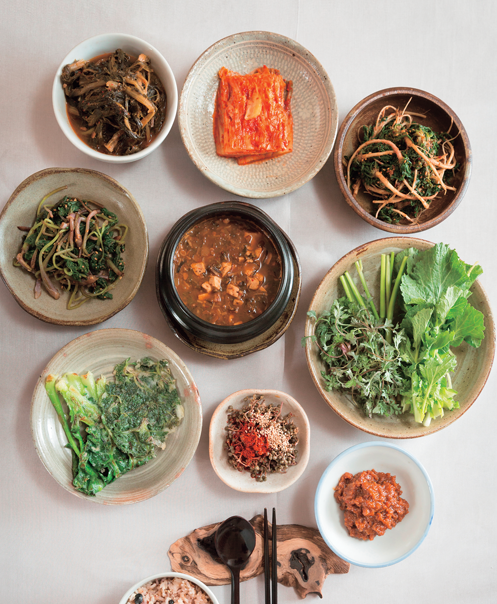
A meal prepared for visitors by the female monks at Yunpil Hermitage in Mungyeong, North Gyeongsang Province. It consists mainly of seasoned wild greens and vegetables, including mugwort, water dropwort, rapeseed and shepherd’s purse picked from the nearby mountains or bought at the local market.
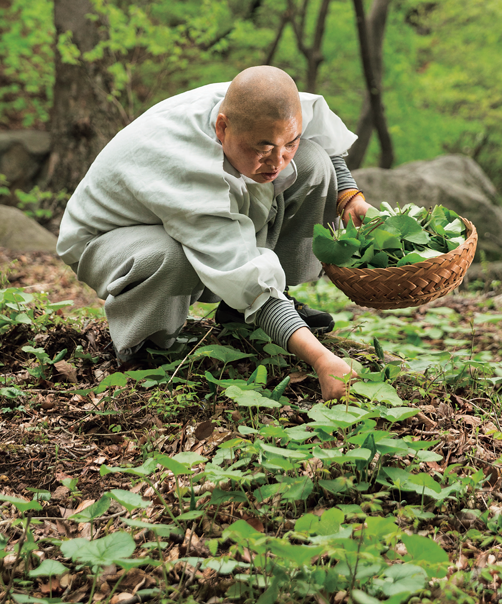
Venerable Gonggok, the head nun of Yunpil Hermitage, plucks gomchwi (Fischer’s ragwort) in the mountain behind the hermitage. A wild vegetable known for its pungent scent and distinctive flavor, gomchwi can be eaten raw or pickled in soy sauce.
Each year when the spring flowers bloom, I read “Bicycle Journeys,” a collection of travel essays by the novelist Kim Hoon. I’ve reread it so many times that some sentences read like a landscape full of flowers outside the window. “Magnolias burst into sudden bloom like a lamp being lit.” “At the height of their bloom, camellias meet their sudden demise like the ancient Baekje Kingdom.” The passages in the book are no longer just printed words but almost feel like a part of my body.
So, it was only natural that as I was admiring the blossoming flowers at Yunpil Hermitage, a sentence from the book popped into my mind: “Cornelian cherry flowers bloom like a shimmering mirage.” This happens every time I feel spring in the air. Whether it is cornelian cherry flowers, cherry blossoms or plum blossoms, they appear to me not as real flowers but the daydream of the tree that has endured the harsh cold of winter. Indeed, spring was bursting into life in the hermitage courtyard. Plum blossoms were in bloom around the nuns’ quarters, as were yellow pheasant’s eye and purple Asian twinleaf.
When I opened the door to the meditation room, a Buddhist nun was brewing coffee and grinding coffee beans in a mortar. The coffee tasted richer and more flavorful than any I had ever had before. I was curious to know the coffee bean variety, but the nun said it was nothing special. After observing the entire brewing process, I realized the secret to its distinctive flavor. The nun placed a generous amount of coffee grounds into the filter but only ran a small amount of water through them. One drop of coffee dripped every two to three seconds, so it took 30 minutes to fill a cup. The brewing method was akin to that for Dutch coffee. She willingly devoted her time to treat guests to a special cup of coffee.
Bustling Kitchen Hall
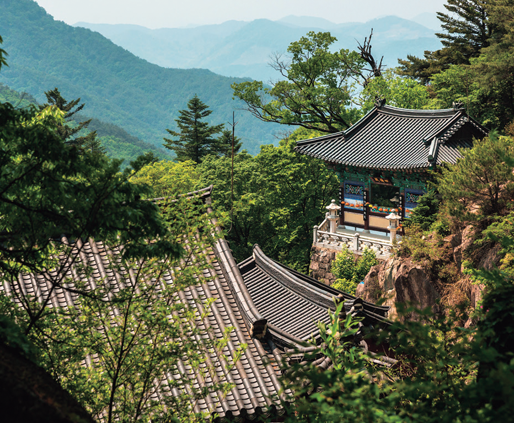
Yunpil Hermitage is a monastery for nuns established in 1380, which is nestled at the foot of Mt. Sabul. The hall seen at the right is Sabuljeon (Hall of Four Buddhas). It has no Buddha statue enshrined, and during worship the monks face the four-sided stone Buddha on top of Mt. Sabul that is visible through a large window.
Wondu refers to the monk appointed as head of the farmyard, tasked with cultivating vegetables, such as red peppers, lettuce, cucumbers, spinach, sunflowers, squash and chard, and supplying them to the temple kitchen. The chapter of “Miscellaneous Duties” in “The Baizhang Zen Monastic Regulations” (Chixiu Baizhang qinggui), a Buddhist text from the Yuan Dynasty delineating monastic codes, states, “The head of the farmyard [yuantou in Chinese] unhesitatingly takes the lead in heavy physical labor. He cultivates the soil, sows seeds for vegetable crops, irrigates the fields when necessary, and thereby provides a steady supply of fresh vegetables and so on to the kitchen hall throughout the year.”“I prefer to do things in a way that feels comfortable and natural,” the nun told me. “Complicated and difficult is not my style. I sleep a lot and don’t like conforming to conventions. I don’t think sitting in strict silence is the only form of meditative practice. Putting your heart into cooking a good meal and making tea for others can also be considered spiritual practice.”
The nun, whose Buddhist name is Gonggok, was like a farmer, mother and chef all rolled into one.
Together with Gyeonseong Hermitage at Sudeok Temple and Jijang Hermitage on Mt. Odae, Yunpil Hermitage, which is under the jurisdiction of Daeseung Temple, is one of the country’s three main Seon (Zen) Buddhism centers for female monastics. It is a place that takes care of the minds and bodies of the female monks who have committed themselves to a period of intense spiritual practice.
The hermitage’s naturally lit kitchen, whose walls were decorated with pretty shadows cast by the sun, bustled with activity all day. At every mealtime, abundant amounts of rice, soup and side dishes must be prepared to feed scores of people. It gets busier around Buddha’s Birthday, when even more people flock to the hermitage. The kitchen was a dynamic place filled with the constant sounds of pounding, crushing and mixing. The baskets there were filled to the brim with spring greens, such as mugwort, shepherd’s purse, rapeseed or butterbur, which were picked from the back gardens or bought at the local market held every five days. The broth for noodles simmered in a large pot.
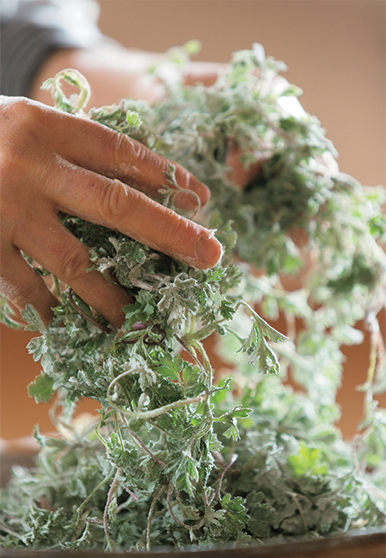
Venerable Gonggok mixes tender young mugwort shoots with rice flour before steaming the mixture. Mugwort rice cake is a popular treat in spring.
Mugwort soup is said to taste the best around March 20, when the leaves are small and soft. The nun makes mugwort tea from the leaves picked around this time, and soap with the leftover ones. Not only mugwort but all kinds of wild plants growing in the mountains make great ingredients. Mulberries, dandelions, tangerine peels and the inner hull of chestnuts can all be used to make tea or soap; they can be either eaten or applied to the skin. I smiled when the nun told me how she was gazing at the bright moon one night when she was struck with a desperate urge to check if any cucumbers had ripened; she found a whole bunch of plump cucumbers dangling from the vine, and picked 200 of them to make spicy stuffed cucumber kimchi. I wondered what kind of life it was — a life in which the moonlight inspires thoughts of cucumbers.
The nun took a while to prepare the food, mostly because of the time devoted to preparing handmade noodles, which involved rolling out the wheat dough and cutting it into long, thin strips with a knife. When she finally came with the meal, it was way past lunchtime and I was hungry. Set next to the noodles in soup were mugwort rice cake, shepherd’s purse and dried radish leaves, seasoned with either soy sauce or fermented soybean paste. The soybean paste stew placed next to the bowl of rice mixed with black beans and winding snoutbeans brought to mind a phrase from Kim Hoon’s book: “The broth of the soybean paste stew, the shepherd’s purse in it and the person eating are in a perpetual love triangle.” But this is a love affair where one side embraces the other two. So, it is peaceful.
I tasted rapeseed salad and mugwort pancakes. The rapeseed leaves conveyed fresh spring energy; the batter for the mugwort pancake was spread out as thinly as possible to bring out the distinctive, pungent flavor of the herbs. Interestingly, water dropwort leaves were served as wraps instead of the usual lettuce or perilla leaves. I had heard the nun say, “I need to show the townies what water dropwort tastes like,” so I figured spring water dropwort must be nutritious. I took a leaf, placed a small lump of rice with a dollop of spicy paste on it, wrapped it up and put it in my mouth. Even before I could chew, the scent permeated my mouth. The side dish of walnuts and almonds lightly roasted in soy sauce tasted more like a snack and I couldn’t stop eating them. I popped a yellow pickled plum into my mouth. The crunchy texture and sweet taste whetted my appetite.
A Monastic’s Recipes
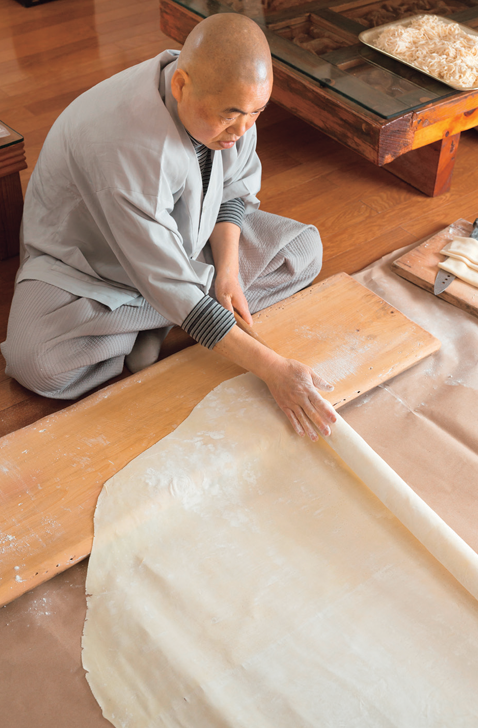
Venerable Gonggok unfolds a thin sheet of rolled flour dough to cut it into long, thin strips with a knife. Handmade noodle soup is a treat for the monks.
There are a few secrets that I gleaned from the chefs I met when I was a reporter covering the restaurant scene. One is to serve hot food hot and cold food cold. Even in-flight meals, which at altitudes of over 30,000 feet are difficult if not impossible to taste good, can be made more palatable by sticking to this principle: serving salads cold, bread warm and coffee hot. Freshly cooked steaming rice, soybean paste stew that is served piping hot in an earthenware bowl, fresh greens that have just been seasoned — at Yunpil Hermitage, it may take a long time to prepare the ingredients, but a short time to cook them. In short, the food here is rooted in the basic principles of cooking.
But the essential ingredients for making food more delicious are time and season. Likewise, the process of aging and fermentation gives kimchi and sauces and pastes a deeper taste and enriches the flavor of coffee. This is not unrelated to why the Venerable Gonggok had said that the whole process of picking, roasting and fermenting tea leaves could be considered a form of spiritual practice.
Eating a meal at the hermitage was a discovery of both the original form of ingredients and their limitations. It was an entirely different experience from eating mindlessly to merely satiate your hunger. In fact, it was more than just visitor experience; it felt like participating in a ritual. If one were to say, “We are eating the essence of spring,” at the sight of the food laid out on the table, it would not be a poetic metaphor but a literal .
When I was staying in Varanasi, India, I came down with severe diarrhea. It was February 22, 2005, the day actress Lee Eun-ju killed herself. The death of an actress I had liked left me in a daze. For reasons that befuddled me, I got up, mustering every last bit of strength left in my body, and took an auto rickshaw and headed for a Korean temple called Nogyawon (Deer Park Monastery) in Sarnath, 10 kilometers from Varanasi. A Christian from birth, I was struck with the sudden thought of going to the Buddhist temple because I recalled another traveler saying you could eat a home-cooked meal there. Imposing on the temple’s hospitality, I devoured soybean paste soup and kimchi. To say that the food gave me the strength to live would sound trite, but thanks to the hearty meal I was able to make the trip to the desert in Jaipur. That day, I experienced firsthand the healing powers of food.
If one were to say, “We are eating the essence of spring,”
at the sight of the food laid out on the table,
it would not be a poetic metaphor but a literal .
Haven for the Soul
At times, I wish I could drown out the loud voice in my head and pay attention to what my body is saying — my stomach, nose and tongue whispering that my stomach is growling, the smell of rice cooking is so tempting, the rice tastes so sweet.
One day, as I was eating a meal, my eyes all puffy, I came to the realization that the hometown is more than just a place, just as hunger may mean more than a physical need or desire for food. A grain of rice may taste sweeter the more you chew it, or soybean paste soup with shepherd’s purse may feel like home.
The Venerable Gonggok smiled as she said, “The mountains are our temple gardens.”
Flowers were in bloom everywhere on the grounds of the hermitage. Wild greens were in abundance all around in the mountains and streams. We all need a home we can always go back to, a safe haven to rest our weary souls. I think Yunpil Hermitage will remain in my heart as such a place.
A Budget-friendly, Healthy Meal
This is a place that could come from Haruki Murakami’s travelogues in “Borders Near and Far,” a restaurant whose owner upon hearing, “Sir, this dish is missing scallions,” would say, “There’s plenty out in the back. Go pick as much as you want to eat.” It is located in a secluded village, the last place you would expect to find a restaurant. However, Geolgujaengine [Geol-gu-jaeng-i-ne], serving temple food for 25 years, bustles with customers from nine in the morning to nine in the evening.
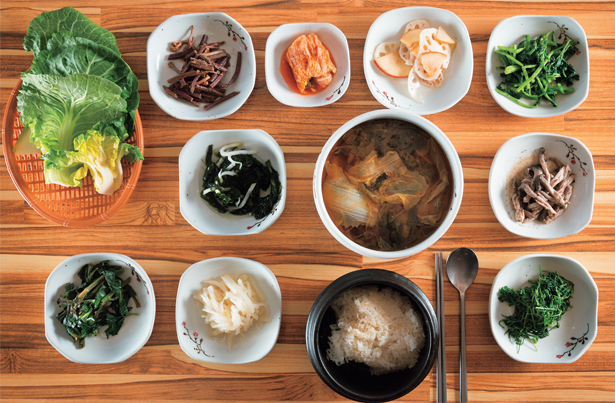
A meal consisting mainly of seasoned vegetable dishes at Geolgujaengine, a temple food restaurant in Yeoju, Gyeonggi Province. The food made without artificial flavorings is loved by many for its fresh, natural taste.
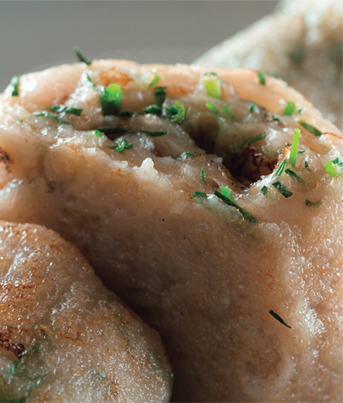
A pancake served as appetizer at this restaurant. Made of chopped seasonal vegetables wrapped in a thin sheet of acorn flour dough, it is pan-fried in oil and cut into bite-sized pieces.
“Our focus is not necessarily temple food, but a nutritious homemade meal,” said the owner. The restaurant, though, is strict about not using the five pungent vegetables — garlic, scallions, wild chives, allium and asafoetida — and any artificial flavor enhancers. Its vegetarian menu also excludes all forms of meat and fish, fresh or preserved.
The restaurant uses only locally and daily sourced seasonal ingredients. The food is mildly seasoned. I chewed slowly, savoring each mouthful, and soon felt quite full even though I had not eaten much.
The meal is served in two parts. The first part includes steamed tofu, salad and cold kimchi noodles with thin slices of lotus root; the second part offers an assortment of seasoned vegetable dishes, rice cooked with thistle (gondeure namul bap) and napa cabbage soybean paste soup. Nothing fancy, but soul food, like a mother’s home-cooked meal prepared with loving care. The owner also prepares a wide variety of teas all year round and serves the one that best fits the season.
After it was featured on a TV show in 2012, the restaurant saw a boom in customers and opened a second restaurant in Seoul. But due to the rising cost of ingredients and difficulties in obtaining quality produce, it was closed down after a year.
Lunch or dinner, a meal is uniformly priced at 15,000 won per person. Only an hour’s drive from Seoul, you can couple it with a trip to Silleuk Temple nearby.
I chewed slowly, savoring each mouthful, and soon felt quite full even though I had not eaten much.
Temple Cuisine at Its Finest
Located across the street from Jogye Temple in downtown Seoul, Balwoo Gongyang was the first restaurant in Asia to receive a Michelin star for temple cuisine, a status it has maintained since 2017. Having been introduced abroad several times, about 35 percent of its customers are from overseas. It is often hard to get a table at lunchtime without a reservation.
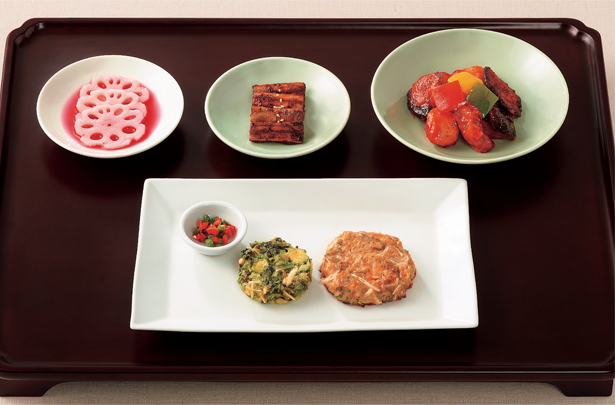
Pickled lotus root, marinated grilled burdock, deep-fried mushrooms coated with rice syrup and red chili paste, and mung bean pancake (clockwise from top left). These dishes, served after the appetizer, have a clean and light taste. They are part of a set menu served at Balwoo Gongyang, a temple cuisine restaurant run by the Jogye Order of Korean Buddhism.
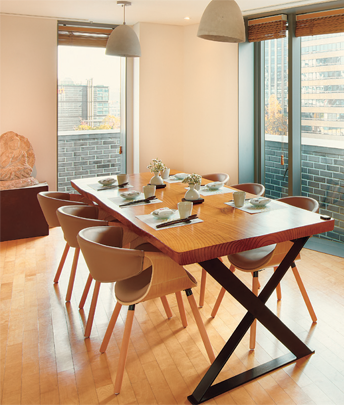
The upscale, modern interior of Balwoo Gongyang, a Michelin one-star restaurant that offers a choice of set menus. © Balwoo Gongyang
The restaurant offers four set menus: Seon (Meditation: 30,000 won) served only at lunchtime, Won (Vow: 45,000 won), Maeum (Mind: 65,000 won) and Hee (Joy: 95,000 won). The prices are pretty hefty, but each dish comes with a detailed explanation about the ingredients and the proper dining etiquette.
Some of the ingredients, such as soy sauce, soybean paste, brown rice vinegar and tofu, are made at Tongdo Temple, a UNESCO World Heritage site, in Yangsan, South Gyeongsang Province. The baru (wooden monastic bowls) made of ginkgo wood and coated with nine s of lacquer add a refined touch.
The highlights of the Won course are the cold noodle dish with spicy shiitake mushrooms and pureed Korean pear, and dumplings filled with various greens, vegetables and nuts. The restaurant’s signature dish, deep-fried mushrooms coated with rice syrup and red chili paste aged three years, called modeum beoseot gangjeong, is both spicy and sweet with a fleshy texture that is sure to appeal to meat lovers and vegetarians alike. The various kinds of kimchi made without garlic have a refreshing end taste and a crisp and crunchy texture.
The restaurant also uses rare and unique ingredients like riverside wormwood, kumquat, cow parsley and Chinese artichoke, which can only be harvested in certain seasons or found only in select regions like remote islands.
On the first floor of the restaurant’s building is the Korean Temple Food Center, where temple food classes are held. Taught by monks, participants can learn not only about the various ingredients and traditional recipes, but also how to develop a mindful attitude toward food.
The various kinds of kimchi made without garlic have a refreshing end taste
and a crisp and crunchy texture.